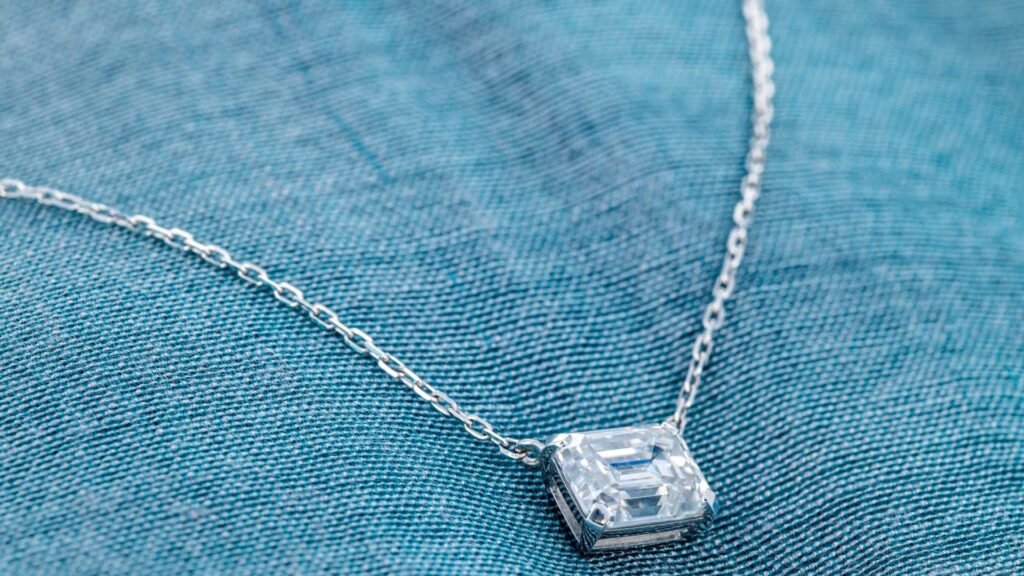What makes a diamond shine? Diamonds shine mainly due to two attributes: their fire and their brilliance. People often think that fire and brilliance are interchangeable terms. But in the context of diamonds, fire and brilliance are two different optical properties that make diamonds unique.
In this article, I will discuss the science behind the brilliance and fire of your diamond. Keep reading to learn what makes your diamond shine!

Why Do Diamonds Shine?
Raw diamonds are formed when carbon deposits (found several miles below the earth’s surface area) are exposed to tremendous pressure and temperature.
But raw diamonds are nothing like the brilliant stone you bought in the velvet box at the jewelry store. Raw diamonds are actually quite dull and rather listless. Looking at them, you might be forgiven to think that they are worthless trinkets.
So how do these raw stones transform into the beautiful and sparkly diamond that we all know and love? The diamond’s shine or sparkle mainly comes in two forms: brilliance and fire.
What Is The Brilliance of a Diamond?
Brilliance is the phenomenon of how well white light is reflected toward the viewer. The more white light is reflected towards your eyes, the more brilliant the diamond will appear.
Factors Affecting Brilliance of a Diamond
The brilliance of the diamond is mainly dependent on three factors: how well the diamond is cut and polished, scintillation or dark facets of the diamond, and inclusions or impurities in them.
1. Cut of a Diamond
The light entering will be reflected in your eyes whenever the diamond is adequately cut. This reflection of the light is known as brilliance. However, only a small portion is reflected towards your eyes, and the rest will travel through it.
If the diamond is cut too shallow, it will reflect most of the light from the bottom portion of the diamond. As a result, most light is not reflected towards your eyes.
If the diamond is cut too deep, light entering the diamond will reflect mainly from the sides of the diamond and not back towards your eyes.
So, if the diamond is cut too deep or shallow, then it will have less brilliance.
However, if the diamond has a good quality cut, then light entering from the top will be reflected mainly from the top portion. Here, most of the light will reflect towards your eyes. A diamond that is well cut will have high brilliance.
2. Scintillation
Many might think that the shine or sparkle of the diamond comes only from white light. However, dark areas also play a vital role in the sparkle of the diamond.
Another factor that significantly affects the brilliance of the diamond is scintillation. There are some facets of the diamond that are dark. When the light enters the diamond, the dark objects will reflect back from the precious stone to your eyes, creating a balance and contrast effect.
A diamond will sparkle without a contrast effect, but that effect would not be as eye-catching. Here are some analogies. The moon looks bright when the sky is dark. A candle glows more brightly in a closed dark room compared to a lit room.
3. Clarity of Diamond
If a diamond has more inclusions or impurities, it blocks some light from entering the diamond. This significantly affects the brilliance or shine of a diamond.
What Is Fire of a Diamond?
A diamond’s fire is the flashes of multiple colors of light that you see when you shine a light on the diamond. A scientific principle known as ‘dispersion’ is the reason you see multiple colors when light falls on a diamond.
What Is Dispersion?
Light travels at different speeds in different mediums. How fast it travels is inversely related to the refractive index of the medium. For example, the air has a refractive index of 1, glass 1.5, and diamonds 2.4. So light travels slower through a diamond.
The white light that we see every day is actually composed of many colors, from a spectrum of violet right up to red, with 7 colors in between. You can see these colors separately every time you see a rainbow. Light splits up in a medium with a high refractive index, because each of these colors travels at a slightly different speed than the others.
So, when white light enters a diamond, these component colors become visible, which is what causes the fire effect. The fire of a diamond depends on the cut and angle at which light is entering. If the diamond is well cut, then it will have maximum fire and brilliance.

Wrapping Up
Brilliance and fire are a diamond’s essential properties that enable the precious stone to shine brightly.
If a diamond has fewer facets, then it will have lesser angles for the light to reflect back towards you. Here, it will produce less brilliance but this will increase the fire of the diamond. Moreover, you will also be able to see inclusions if there are fewer facets.
After a stonecutter cuts the diamond, it is carefully polished. The quality of polishing also has an effect on the brilliance of a diamond.
Related articles:
What Are Loose Diamonds?
Ideal vs. Super Ideal Cut Diamond
Tanzanite Vs. Diamonds: What’s the Difference?






